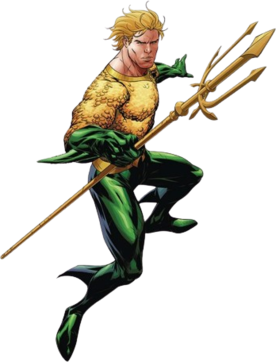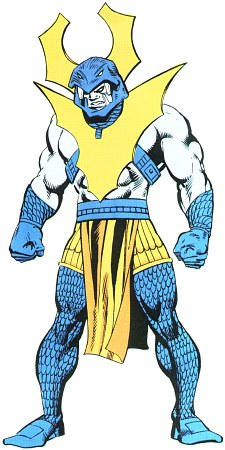
Aquaman is a superhero appearing in American comic books published by DC Comics. Created by Paul Norris and Mort Weisinger, the character debuted in More Fun Comics #73. Initially a backup feature in DC's anthology titles, Aquaman later starred in several volumes of a solo comic book series. During the late 1950s and 1960s superhero-revival period known as the Silver Age, he was a founding member of the Justice League. In the 1990s Modern Age, writers interpreted Aquaman's character more seriously, with storylines depicting the weight of his role as king of Atlantis.

The spinner dolphin is a small dolphin found in off-shore tropical waters around the world. It is famous for its acrobatic displays in which it rotates around its longitudinal axis as it leaps through the air. It is a member of the family Delphinidae of toothed whales.

Black Manta is a supervillain appearing in American comic books published by DC Comics. Created by Bob Haney and Nick Cardy, the character first appeared in Aquaman #35. He has since endured as the archenemy of the superhero Aquaman.

The legendary island of Atlantis has often been depicted in literature, television shows, films and works of popular culture.

Ocean Master is a supervillain appearing in American comic books published by DC Comics. The character was created by Bob Haney and Nick Cardy and debuted in Aquaman #29. While the character is depicted as the half-brother and one of the most enduring and recognized adversaries of Aquaman, Ocean Master has been subjected to numerous revisions to his origin stories throughout his history.

Tiger Shark is a supervillain appearing in American comic books published by Marvel Comics. Created by writer Roy Thomas and artist John Buscema, the character first appeared in Prince Namor, the Sub-Mariner #5. Todd Arliss is a recurring antagonist of the antihero Namor. His powers come from both the DNA of Namor and shark DNA. He is also known under the codename Tiger Shark.

Operation Atlantis was a project started by Werner Stiefel in 1968 aiming to establish a new, libertarian nation in international waters. The operation launched a ferro-cement boat on the Hudson River in December 1971 and piloted it to an area near the Bahamas. Upon reaching its destination, it sank in a hurricane. After a number of subsequent failed attempts to construct a habitable sea platform and achieve sovereign status, the project was abandoned.

Mera is a superheroine appearing in American comic books published by DC Comics. Created by Jack Miller and Nick Cardy, the character first appeared in Aquaman #11.

Attuma is a supervillain appearing in American comic books published by Marvel Comics. He is an Atlantean nomadic warlord who is usually depicted as an enemy of Namor the Sub-Mariner, and is the father of the superhero Andromeda. He believes he is the prophesied conqueror of the Atlantean Empire.

Atlantis Underwater Tycoon is an underwater city-building simulation game in which the player acts as a tycoon to simulate the real-time design and management of an underwater civilization. It was developed by American studio Anarchy Enterprises and published by Activision Value, and released on March 21, 2003, for Microsoft Windows.

Let's Go Jungle!: Lost on the Island of Spice is a joystick-mounted gun arcade game by Sega. Players take the roles of Ben and Norah stranded on a jungle island which has been overrun by monsters. Each player must shoot the monsters with their machine gun while looking for rescue.
Giganto is a fictional monster appearing in the American comic books published by Marvel Comics. Giganto has been seen across two separate instances in the Marvel Universe.
Atlantis is a fictional location appearing in American comic books published by Marvel Comics. It is based on the mythical island of Atlantis first mentioned in Plato's initial dialogue the Timaeus, written c. 360 BC. In the Marvel Universe, Atlantis was a small continent with many human settlements. Over 21,000 years ago, an event called the "Great Cataclysm" caused it to be submerged into the sea.

Atlantis, sometimes also called the Kingdom of Atlantis or the Atlantean Empire, is a fictional civilization appearing American comic books published by DC Comics based upon the mentioning of the island within Plato's works Timaeus and Critias. First appearing in More Fun Comics #87, the setting is often associated with the hero Aquaman. Within the DC Universe, Atlantis houses various aquatic-based human lifeforms whose biological adaptations often originate from both environmental changes when Atlantis sunk in a cataclysmic event within its history and influence from its magical origins. A nation considered a superpower, it is often stated to be among the oldest and most sophisticated civilization within the fictional universe throughout its collective history and possess significant technological and magical capabilities. Historically a hereditary monarchy, many stories involving Atlantis as a setting focuses on conflicts regarding its succession of leaders, diplomatic relations with the global world, and its fictional cultural heritage.
Lego Atlantis was a product range of the construction toy Lego, themed around the underwater world of Atlantis. The range was launched in early 2010 and discontinued by the end of 2011. The toy sets included models of buildable underwater vehicles, as well as "heroic diver" and "shark warrior" minifigures. A ride based on the range was operated at Legoland Windsor Resort.
The Trench is the name applied to both a fictional kingdom, and its inhabitants as a group, that escaped the destruction of Atlantis in DC Comics.

Forbidden Island is a cooperative board game developed by Matt Leacock and published by Gamewright Games in 2010. Two to four players take the roles of different adventurers, moving around a mysterious island and looking for hidden treasures as the island sinks around them. All players win if they find all the hidden treasures and they all make it back to the helicopter and fly away, and they all lose if they cannot.

Lego DC Comics Super Heroes: Aquaman – Rage of Atlantis is a 2018 American animated superhero comedy film, based on the DC Comics and Lego brands featuring the character Aquaman. The film features the voices of Dee Bradley Baker, Troy Baker, Grey Griffin, and Nolan North. Directed by Matt Peters, written by Jim Krieg and Jeremy Adams, and produced by DC Entertainment, the Lego Group, and Warner Bros. Animation, it is the eighth film in the Lego DC Comics Super Heroes series.
The fictional island of Atlantis frequently appears in popular culture, especially in comic books. The most notable examples are commonly related to Namor of Marvel Comics and a particular version of Aquaman in DC Comics.

















